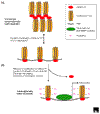Histone variants: are they functionally heterogeneous?
- PMID: 11516340
- PMCID: PMC139417
- DOI: 10.1186/gb-2001-2-7-reviews0006
Histone variants: are they functionally heterogeneous?
Abstract
In most eukaryotes, histones, which are the major structural components of chromatin, are expressed as a family of sequence variants encoded by multiple genes. Because different histone variants can contribute to a distinct or unique nucleosomal architecture, this heterogeneity can be exploited to regulate a wide range of nuclear functions, and evidence is accumulating that histone variants do indeed have distinct functions.
Figures

References
-
- van Holde KE. Chromatin New York: Springer, 1989.
-
- Wolffe A. Chromatin: structure and function San Diego: Academic Press, 1998.
-
- Thomas JO. Histone H1: location and role. Curr Opin Cell Biol. 1999;11:312–317. - PubMed
-
- Cole RD. Microheterogeneity in H1 histones and its consequences. Int J Pept Protein Res. 1987;30:433–449. - PubMed
Publication types
MeSH terms
Substances
LinkOut - more resources
Full Text Sources

